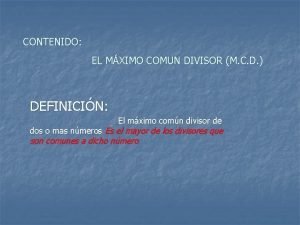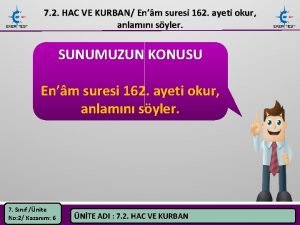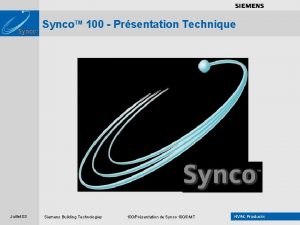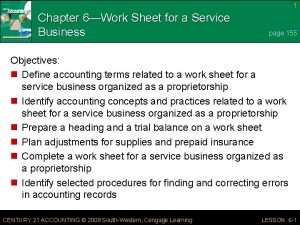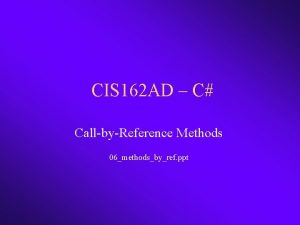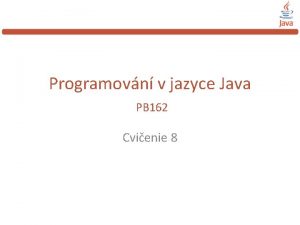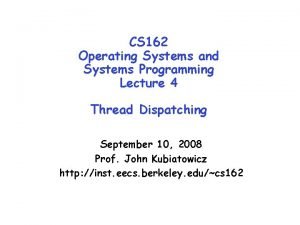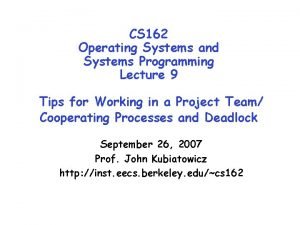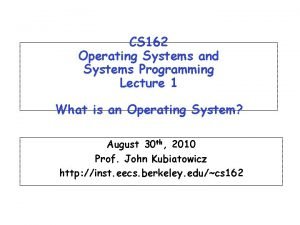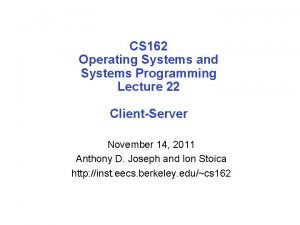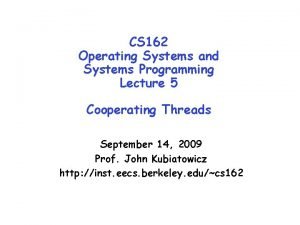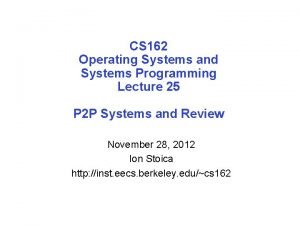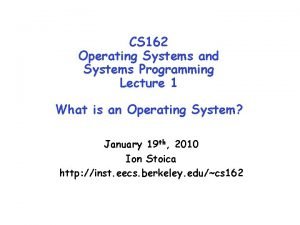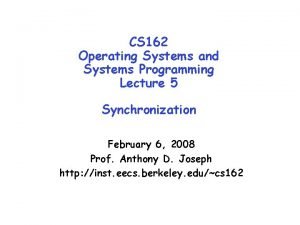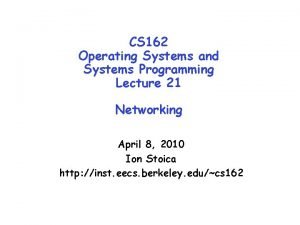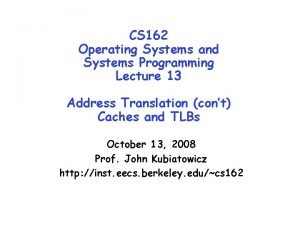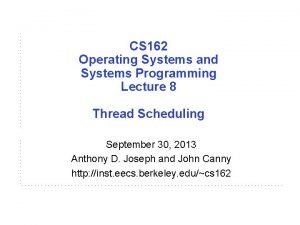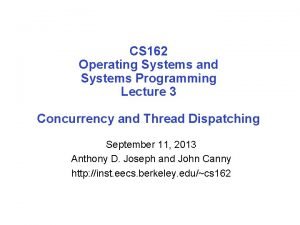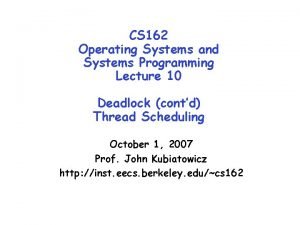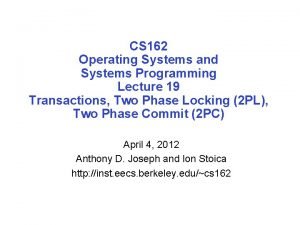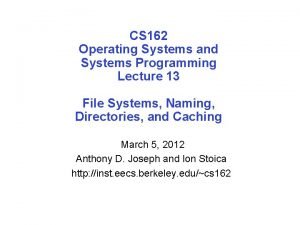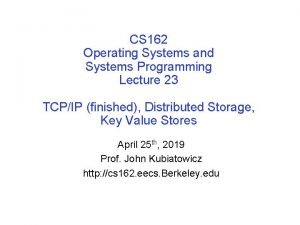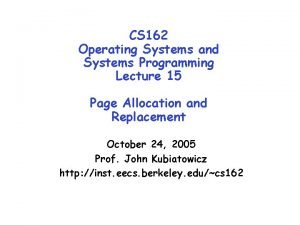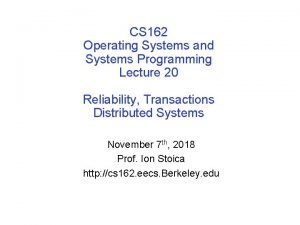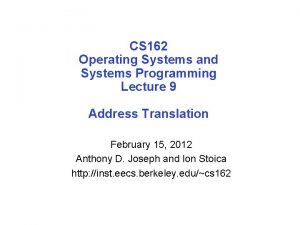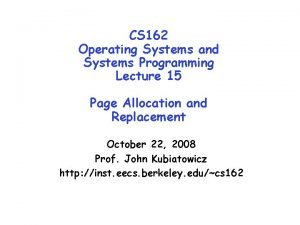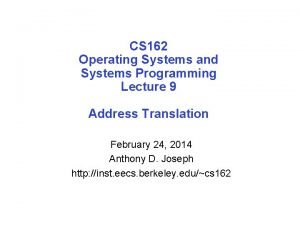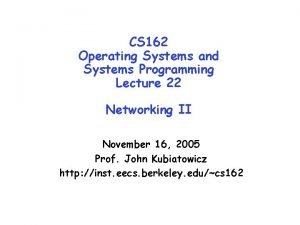CS 162 Operating Systems and Systems Programming Lecture


























- Slides: 26

CS 162 Operating Systems and Systems Programming Lecture 14 File Systems (cont’d), Key Value Storage Systems October 17, 2012 Ion Stoica http: //inst. eecs. berkeley. edu/~cs 162

Recap: File System Goals • Maximize sequential performance • Efiicient random access to file • Easy management of files (growth, truncation, etc) 10/17 Ion Stoica CS 162 ©UCB Fall 2012 Lec 14. 2

Recap: Linked Allocation • MSDOS links pages together to create a file – Links not in pages, but in the File Allocation Table (FAT) » FAT contains an entry for each block on the disk » FAT Entries corresponding to blocks of file linked together – Access properties: » Sequential access expensive unless FAT cached in memory » Random really expensive if FAT not cached 10/17 Ion Stoica CS 162 ©UCB Fall 2012 Lec 14. 3

Multilevel Indexed Files (UNIX 4. 1) • Multilevel Indexed Files: (from UNIX 4. 1 BSD) – Key idea: efficient for small files, but still allow big files • File hdr contains 13 pointers – Fixed size table, pointers not all equivalent – This header is called an “inode” in UNIX • File Header format: – First 10 pointers are to data blocks – Ptr 11 points to “indirect block” containing 256 block ptrs – Pointer 12 points to “doubly indirect block” containing 256 indirect block ptrs for total of 64 K blocks – Pointer 13 points to a triply indirect block (16 M blocks) 10/17 Ion Stoica CS 162 ©UCB Fall 2012 Lec 14. 4

Multilevel Indexed Files (UNIX 4. 1): Discussion • Basic technique places an upper limit on file size that is approximately 16 Gbytes – Designers thought this was bigger than anything anyone would need. Much bigger than a disk at the time… – Fallacy: today, Facebook gets hundreds of TBs of logs every day! • Pointers get filled in dynamically: need to allocate indirect block only when file grows > 10 blocks – On small files, no indirection needed 10/17 Ion Stoica CS 162 ©UCB Fall 2012 Lec 14. 5

Example of Multilevel Indexed Files • Sample file in multilevel indexed format: – How many accesses for block #23? (assume file header accessed on open)? » Two: One for indirect block, one for data – How about block #5? » One: One for data – Block #340? » Three: double indirect block, and data • UNIX 4. 1 Pros and cons – Pros: Simple (more or less) Files can easily expand (up to a point) Small files particularly cheap and easy – Cons: Lots of seeks Very large files must read many indirect blocks (four I/O’s per block!) 10/17 Ion Stoica CS 162 ©UCB Fall 2012 Lec 14. 6

UNIX BSD 4. 2 • Same as BSD 4. 1 (same file header and triply indirect blocks), except incorporated ideas from Cray-1 DEMOS: – Uses bitmap allocation in place of freelist – Attempt to allocate files contiguously – 10% reserved disk space (mentioned next slide) – Skip-sector positioning (mentioned in two slides) • Problem: When create a file, don’t know how big it will become (in UNIX, most writes are by appending) – How much contiguous space do you allocate for a file? – In BSD 4. 2, just find some range of free blocks » Put each new file at the front of different range » To expand a file, you first try successive blocks in bitmap, then choose new range of blocks – Also in BSD 4. 2: store files from same directory near each other 10/17 Ion Stoica CS 162 ©UCB Fall 2012 Lec 14. 7

How to Deal with Full Disks? • In many systems, disks are always full – EECS department growth: 300 GB to 1 TB in a year (now 10 s TB) – How to fix? Announce disk space is low, so please delete files? » Don’t really work: people try to store their data faster – Sidebar: Perhaps we are getting out of this mode with new disks… However, let’s assume disks are full for now • Solution: – Don’t let disks get completely full: reserve portion » Free count = # blocks free in bitmap » Scheme: Don’t allocate data if count < reserve – How much reserve do you need? » In practice, 10% seems like enough – Tradeoff: pay for more disk, get contiguous allocation » Since seeks so expensive for performance, this is a very good tradeoff 10/17 Ion Stoica CS 162 ©UCB Fall 2012 Lec 14. 8

Attack of the Rotational Delay • Problem: Missing blocks due to rotational delay – Issue: Read one block, do processing, and read next block. In meantime, disk has continued turning: missed next block! Skip Sector Track Buffer (Holds complete track) – Solution 1: Skip sector positioning (“interleaving”) » Place the blocks from one file on every other block of a track: give time for processing to overlap rotation – Solution 2: Read ahead: read next block right after first, even if application hasn’t asked for it yet » This can be done either by OS (read ahead) » By disk itself (track buffers). Many disk controllers have internal RAM that allows them to read a complete track • Important aside: Modern disks+controllers do many complex things “under the covers” – Track buffers, elevator algorithms, bad block filtering 10/17 Ion Stoica CS 162 ©UCB Fall 2012 Lec 14. 9

Quiz 14. 1: File Systems • Q 1: True _ False _ With FAT, pointers are maintained in the data blocks • Q 2: True _ False _ Unix file system is more efficient than FAT for random access • Q 3: True _ False _ The “Skip Sector Positioning” technique allows reading consecutive blocks on a track • Q 4: True _ False _ Maintaining the free blocks in a list is more efficient than using a bitmap • Q 5: True _ False _ In Unix, accessing randomly data in a large file is on average slower than in a small file 10/17 Ion Stoica CS 162 ©UCB Fall 2012 Lec 14. 10

Quiz 14. 1: File Systems X With FAT, pointers are maintained in • Q 1: True _ False _ the data blocks X False _ Unix file system is more efficient than • Q 2: True _ FAT for random access • Q 3: True _ False _ X The “Skip Sector Positioning” technique allows reading consecutive blocks on a track X Maintaining the free blocks in a list is • Q 4: True _ False _ more efficient than using a bitmap X False _ In Unix, accessing randomly data in a • Q 5: True _ large file is on average slower than in a small file 10/17 Ion Stoica CS 162 ©UCB Fall 2012 Lec 14. 11

How do we actually access files? • All information about a file contained in its file header – UNIX calls this an “inode” » Inodes are global resources identified by index (“inumber”) – Once you load the header structure, all blocks of file are locatable • Question: how does the user ask for a particular file? – One option: user specifies an inode by a number (index). » Imagine: open(“ 14553344”) – Better option: specify by textual name » Have to map name inumber – Another option: Icon » This is how Apple made its money. Graphical user interfaces. Point to a file and click 10/17 Ion Stoica CS 162 ©UCB Fall 2012 Lec 14. 12

Naming • Naming (name resolution): process by which a system translates from user-visible names to system resources • In the case of files, need to translate from strings (textual names) or icons to inumbers/inodes • For global file systems, data may be spread over globe need to translate from strings or icons to some combination of physical server location and inumber 10/17 Ion Stoica CS 162 ©UCB Fall 2012 Lec 14. 13

Directories • Directory: a relation used for naming – Just a table of (file name, inumber) pairs • How are directories constructed? – Directories often stored in files » Reuse of existing mechanism » Directory named by inode/inumber like other files – Needs to be quickly searchable » Options: Simple list or Hashtable » Can be cached into memory in easier form to search • How are directories modified? – Originally, direct read/write of special file – System calls for manipulation: mkdir, rmdir – Ties to file creation/destruction » On creating a file by name, new inode grabbed and associated with new file in particular directory 10/17 Ion Stoica CS 162 ©UCB Fall 2012 Lec 14. 14

Directory Organization • Directories organized into a hierarchical structure – Seems standard, but in early 70’s it wasn’t – Permits much easier organization of data structures • Entries in directory can be either files or directories • Files named by ordered set (e. g. , /programs/p/list) 10/17 Ion Stoica CS 162 ©UCB Fall 2012 Lec 14. 15

Directory Structure • Not really a hierarchy! – Many systems allow directory structure to be organized as an acyclic graph or even a (potentially) cyclic graph – Hard Links: different names for the same file » Multiple directory entries point at the same file – Soft Links: “shortcut” pointers to other files » Implemented by storing the logical name of actual file 10/17 Ion Stoica CS 162 ©UCB Fall 2012 Lec 14. 16

Directory Structure • Name Resolution: The process of converting a logical name into a physical resource (like a file) – Traverse succession of directories until reach target file – Global file system: May be spread across the network 10/17 Ion Stoica CS 162 ©UCB Fall 2012 Lec 14. 17

Directory Structure (Con’t) • How many disk accesses to resolve “/my/book/count”? – Read in file header for root (fixed spot on disk) – Read in first data block for root » Table of file name/index pairs. Search linearly – ok since directories typically very small – Read in file header for “my” – Read in first data block for “my”; search for “book” – Read in file header for “book” – Read in first data block for “book”; search for “count” – Read in file header for “count” • Current working directory: Per-address-space pointer to a directory (inode) used for resolving file names – Allows user to specify relative filename instead of absolute path (say CWD=“/my/book” can resolve “count”) 10/17 Ion Stoica CS 162 ©UCB Fall 2012 Lec 14. 18

Where are inodes stored? • In early UNIX and DOS/Windows’ FAT file system, headers stored in special array in outermost cylinders – Header not stored anywhere near the data blocks. To read a small file, seek to get header, seek back to data. – Fixed size, set when disk is formatted. At formatting time, a fixed number of inodes were created (They were each given a unique number, called an “inumber”) 10/17 Ion Stoica CS 162 ©UCB Fall 2012 Lec 14. 19

Where are inodes stored? • Later versions of UNIX moved the header information to be closer to the data blocks – Often, inode for file stored in same “cylinder group” as parent directory of the file (makes an ls of that directory run fast). – Pros: » UNIX BSD 4. 2 puts a portion of the file header array on each cylinder. For small directories, can fit all data, file headers, etc. in same cylinder no seeks! » File headers much smaller than whole block (a few hundred bytes), so multiple headers fetched from disk at same time » Reliability: whatever happens to the disk, you can find many of the files (even if directories disconnected) – Part of the Fast File System (FFS) » General optimization to avoid seeks 10/17 Ion Stoica CS 162 ©UCB Fall 2012 Lec 14. 20

In-Memory File System Structures • Open system call: – Resolves file name, finds file control block (inode) – Makes entries in per-process and system-wide tables – Returns index (called “file handle”) in open-file table 10/17 Ion Stoica CS 162 ©UCB Fall 2012 Lec 14. 21

In-Memory File System Structures • Read/write system calls: – Use file handle to locate inode – Perform appropriate reads or writes 10/17 Ion Stoica CS 162 ©UCB Fall 2012 Lec 14. 22

Quiz 14. 1: File Systems • Q 1: True _ False _ A hard-link is a pointer to other file • Q 2: True _ False _ inumber is the id of a block • Q 3: True _ False _ Typically, directories are stored as files • Q 4: True _ False _ Storing file headers on the outermost cylinders minimizes the seek time 10/17 Ion Stoica CS 162 ©UCB Fall 2012 Lec 14. 23

Quiz 14. 1: File Systems X A hard-link is a pointer to other file • Q 1: True _ False _ X inumber is the id of a block • Q 2: True _ False _ • Q 3: True X_ False _ Typically, directories are stored as files X Storing file headers on the outermost • Q 4: True _ False _ cylinders minimizes the seek time 10/17 Ion Stoica CS 162 ©UCB Fall 2012 Lec 14. 24

File System Summary (1/2) • File System: – Transforms blocks into Files and Directories – Optimize for access and usage patterns – Maximize sequential access, allow efficient random access • File (and directory) defined by header, called “inode” • Multilevel Indexed Scheme – Inode contains file info, direct pointers to blocks, – indirect blocks, doubly indirect, etc. . 10/17 Ion Stoica CS 162 ©UCB Fall 2012 Lec 14. 25

File System Summary (2/2) • 4. 2 BSD Multilevel index files – Inode contains pointers to actual blocks, indirect blocks, double indirect blocks, etc. – Optimizations for sequential access: start new files in open ranges of free blocks, rotational Optimization • Naming: act of translating from user-visible names to actual system resources – Directories used for naming for local file systems 10/17 Ion Stoica CS 162 ©UCB Fall 2012 Lec 14. 26
 Operating systems lecture notes
Operating systems lecture notes 01:640:244 lecture notes - lecture 15: plat, idah, farad
01:640:244 lecture notes - lecture 15: plat, idah, farad C data types with examples
C data types with examples Prime factorization of 180 using exponents
Prime factorization of 180 using exponents Speed velocity and acceleration quiz
Speed velocity and acceleration quiz Scomposizione in fattori primi di 162
Scomposizione in fattori primi di 162 Lcm of 150 and 180
Lcm of 150 and 180 Mínimo común múltiplo de 162 234 y 198
Mínimo común múltiplo de 162 234 y 198 Apsc 162
Apsc 162 What is the prime factorization of 24
What is the prime factorization of 24 Komulator
Komulator 18/36 simplified
18/36 simplified 1. 6-1 work together, p. 162
1. 6-1 work together, p. 162 6-1 work together p. 162 answers
6-1 work together p. 162 answers What is written on the three-line heading on a work sheet
What is written on the three-line heading on a work sheet 7 sınıf en'âm suresi 162. ayet
7 sınıf en'âm suresi 162. ayet Rle 162
Rle 162 6-1 work together p. 162
6-1 work together p. 162 Hlinex, 0,1,2,3 hlinef (x),6,18,54,162 hline
Hlinex, 0,1,2,3 hlinef (x),6,18,54,162 hline 162 ad
162 ad Pb162
Pb162 Cs 162
Cs 162 Cs 162
Cs 162 Cs 162
Cs 162 Cs 162
Cs 162 Abcdefghijklmnopqrstvwxyz
Abcdefghijklmnopqrstvwxyz Perbedaan linear programming dan integer programming
Perbedaan linear programming dan integer programming







